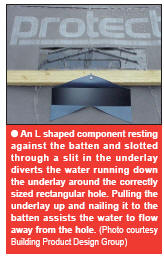 |
 |
 |
 |
 |
 |
 |
|
Check out our web directory of the UK
roofing and cladding industry
www.roofinfo.co.uk |
Sign up for our monthly news letter. |
|
|
|

It never ceases to
amaze me that a roof tiler will spend hours carefully laying out underlay
across the roof, lapping it correctly to prevent water on the underlay
penetrating through what is the secondary waterproof layer of the roof,
then proceed to cut unprotected holes through it for roof windows, pipes,
flues, vents, cables or safety anchors. Often the existence of a hole in
the underlay is only detected when a leak higher up the roof drains down
through the unprotected hole, damaging internal decorations.
Function
The underlay is an essential element of the roof as it is a:
- temporary roof covering against heavy rain during construction,
which lasts up until the final ridge or hip tile is secured.
- barrier to dust and snow that will penetrate the laps of the tiles.
When temperatures rise the melted snow runs down the underlay, whilst dust
will gravitate down the underlay more slowly depending upon the pitch of
the roof.
- collector of condensation that forms on the underside of the roof
during cold, damp weather.
- diaphragm to separate positive air pressure in the building from
acting on the underside of the roof covering during periods of high wind
suction.
A hole in the
underlay can contribute to a loss of tiles or slates under extreme wind
conditions.
- barrier to keep insects and small animals from entering the roof.
Small insects will always be able to enter the batten cavity, but if the
corrugations of a profiled tile are not closed off at the eaves, large
insects and small animals can easily get into the batten cavity from the
gutters.
Problem areas
- Underlay should not come within 25mm of a hot flue pipe. This is
less of a problem with the new design of condensing boiler, as flue pipe
temperatures are lower.
- Proprietary underlay seals glued to the underlay may not work with
banded bitumen underlay.
|
 |
| - Few proprietary components for protecting a hole in underlay manage
to reinstate all the functions of the underlay and those that do tend to
be difficult to fit. The process of cutting an ‘X’ in the underlay and
folding back the loose sections around the pipe is common but not an
adequate solution. Often fixing instructions are ignored or the components
thrown away. This situation is not helped by supervision not detecting
that compliance with fixing instructions, drawings and specification has
not been achieved.
Advice
All holes through the underlay need to be protected. A tight fitting metall
or plastic seal, similar to a lead slate, lapped into the underlay tends
to be the most effective method of sealing the hole. If from inside the
roof you can see the underside of the roof covering around the pipe or
duct through the underlay, then protection to the hole is unlikely to be
adequate. Round pipes can be difficult to protect. Square ducts are
simpler, but have vulnerable corners. They can be sealed using lapped
sections of underlay laid up the face of the duct. If there is no pipe or
duct passing through the
underlay, protecting the hole is more difficult. Keep the number and size
of penetrations through the roof to an absolute minimum and as high up the
roof slope as possible.
|
| Compiled by Chris Thomas, The Tiled
Roofing Consultancy, 2 Ridlands Grove, Limpsfield Chart, Oxted, Surrey,
RH8 0ST, tel 01883 724 774. |
|